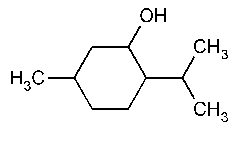Menthol
»Menthol is an alcohol obtained from diverse mint oils or prepared synthetically.Menthol may be levorotatory (l-Menthol),from natural or synthetic sources,or racemic (dl-Menthol).
Packaging and storage—
Preserve in tight containers,preferably at controlled room temperature.
Labeling—
Label it to indicate whether it is levorotatory or racemic.
Identification—
When it is triturated with about an equal weight of camphor,of chloral hydrate,or of phenol,the mixture liquefies.
Congealing range of dl-Menthol á651ñ—
[NOTE—Perform this test preferably in a room having a temperature below 30 and a relative humidity below 50%.]Place about 10g of racemic Menthol,previously dried in a desiccator over silica gel for 24hours,in a dry test tube of from 18-to 20-mm internal diameter,and melt the contents at a temperature of about 40
and a relative humidity below 50%.]Place about 10g of racemic Menthol,previously dried in a desiccator over silica gel for 24hours,in a dry test tube of from 18-to 20-mm internal diameter,and melt the contents at a temperature of about 40 .Suspend the test tube in water having a temperature of 23
.Suspend the test tube in water having a temperature of 23 to 25
to 25 ,and stir the contents of the tube continually with a thermometer,keeping the bulb of the thermometer immersed in the liquid.Racemic Menthol congeals at a temperature between 27
,and stir the contents of the tube continually with a thermometer,keeping the bulb of the thermometer immersed in the liquid.Racemic Menthol congeals at a temperature between 27 and 28
and 28 .Shortly after the temperature has stabilized at the congealing point,add a few mg of dried racemic Menthol to the congealed mass,and continue the stirring:after a few minutes the temperature of the mass quickly rises to 30.5
.Shortly after the temperature has stabilized at the congealing point,add a few mg of dried racemic Menthol to the congealed mass,and continue the stirring:after a few minutes the temperature of the mass quickly rises to 30.5 to 32.0
to 32.0 .
.
Specific rotation á781Sñ:
between -45 and -51
and -51 for l-Menthol;between -2
for l-Menthol;between -2 and +2
and +2 for dl-Menthol.
for dl-Menthol.
Test solution:
100mg per mL,in alcohol.
Limit of nonvolatile residue—
Volatilize 2g,accurately weighed,in a tared open porcelain dish on a steam bath,and dry the residue at 105 for 1hour:the residue weighs not more than 1mg (0.05%).
for 1hour:the residue weighs not more than 1mg (0.05%).
Chromatographic purity—
System suitability preparation—
Dissolve decanol and Menthol in ether to obtain a solution having concentrations of about 0.05mg of each per mL.
Test preparation—
Dissolve 10mg of Menthol in 50mLof ether,and mix.Dilute 25mLof this solution with ether to 100mL,and mix.
Chromatographic system—
The gas chromatograph is equipped with a flame-ionization detector and contains a 1.8-m ×2-mm column packed with 10%phase G16on support S1AB.The column is maintained at about 170 ,the injection port is maintained at about 260
,the injection port is maintained at about 260 ,and the detector block is maintained at about 240
,and the detector block is maintained at about 240 .Dry helium is used as the carrier gas at a flow rate of about 50mLper minute.Chromatograph the System suitability preparation,and record the peak responses as directed under Procedure:the retention time of menthol is about 0.7relative to decanol.In a suitable chromatogram,the resolution,R,of the 2peaks is not less than 2.5,and the relative standard deviation of the ratio of the peak response obtained with menthol to that obtained with decanol is not more than 2%.
.Dry helium is used as the carrier gas at a flow rate of about 50mLper minute.Chromatograph the System suitability preparation,and record the peak responses as directed under Procedure:the retention time of menthol is about 0.7relative to decanol.In a suitable chromatogram,the resolution,R,of the 2peaks is not less than 2.5,and the relative standard deviation of the ratio of the peak response obtained with menthol to that obtained with decanol is not more than 2%.
Procedure—
Inject about 2µLof the Test preparationinto the gas chromatograph,and measure the peak responses.The peak response due to menthol is not less than 97%of the sum of all the peak responses,excluding any due to the ether.
Readily oxidizable substances in dl-Menthol—
Place 500mg of dl-Menthol in a clean,dry test tube,add 10mLof a solution of potassium permanganate,prepared by diluting 3mLof 0.1Npotassium permanganate with water to 100mL,and place the test tube in a beaker of water at a temperature between 45 and 50
and 50 .Remove the tube from the bath at intervals of 30seconds,and mix quickly by shaking:the purple color of potassium permanganate is still apparent after 5minutes.
.Remove the tube from the bath at intervals of 30seconds,and mix quickly by shaking:the purple color of potassium permanganate is still apparent after 5minutes.
Organic volatile impurities,Method Vá467ñ:
meets the requirements.
Solvent—
Use dimethyl sulfoxide.
Auxiliary Information—
Staff Liaison:Gabriel I.Giancaspro,Ph.D.,Senior Scientist and Latin American Specialist
Expert Committee:(DSB)Dietary Supplements:Botanicals
USP28–NF23Page 1207
Phone Number:1-301-816-8343
